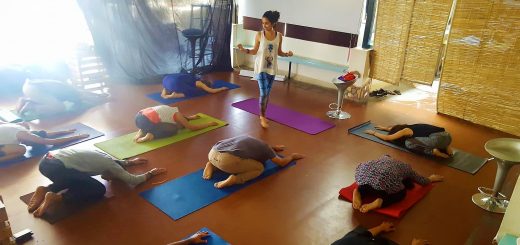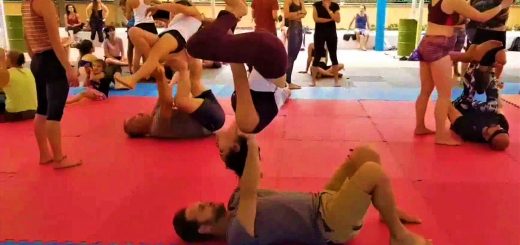Flat Abs, 6-Pack Abs or Core Strength?
“6 moves to flat abs in 6 days, Get a flat belly fast! Lose your gut in 5 days, 8-pack abs in just 8 minutes a day, 6-pack abs in 6 moves” – we’ve all seen these exhortations screaming off health magazine covers month after month. ‘Flat Abs’ and ‘6-pack’ are to health magazines what ‘World Peace’ and ‘Mother Teresa’ are to beauty pageants. They’d never feel complete without them, for reasons equally superficial. If only they’d live up to their promises, we’d run into flat abs and world peace so much more often.
Given that tight, ripped abs are widely hailed as definitive proof of health, how can the hype be questioned?
Flat and ripped abs are often projected as hallmarks of health to an increasingly misinformed audience. The accompanying risks of dangerously low fat percentages, hormonal and muscular imbalances, and bone weakness are the well-hidden fine print. And the unsung hero – Core Strength – being less of a catchphrase, generally stays outside the limelight.
Before going hammer and tongs at the abs to flatten/rip them, it may be worthwhile to renew one’s acquaintance with the core, and give it some basic scientific attention. As your body’s foundation – the centre of its strength, stability and movement – the core is of central importance to the body. And, if you’re ready to hear it, there is a lot more to a strong core than the famous ‘6-pack’ or flat abs.
KNOW YOUR CORE
The core consists of the group of muscles in the centre of the body –encompassing the abdomen, lower and upper back, hips, butt and inner thighs – together the powerhouse of the body. These are the nearly 30 different muscles in the area between the hips and ribcage.
The 2 types of muscles here are those responsible for:
- Stabilizing the trunk,
- Providing movement of the trunk.
Together, they work to stabilize the entire body – in stillness and in movement. The only time your deep core muscles are at rest is when you are lying down on your back.
WHY IS THE CORE SO IMPORTANT?
Strength is built from deep inside the core. The small spinal vertebrae being the only bones between the ribcage and pelvis, the entire midsection depends on muscles for protection and support. Forming a bridge between the lower and the upper body, the core acts as the entire body’s foundation.
BENEFITS OF A STRONG CORE
Ask not just what you can do for your core, but what your core can do for you –
- Strongly supported low back, preventing backaches.
- Added stability to pelvis, knee, ankle and shoulders
- Prevention of injuries to muscles and joints: Many back and knee injuries can be traced back to weaknesses in the core
- Increased range of motion
- Enhanced athletic performance
- Optimal load-sharing of the body
- Counteraction of the effect of gravity on the joints
- Greater functional fitness
- Greater energy levels and vitality through the day.
The more developed your core is, the better your body will be able to respond to demands placed upon it. A weak core, being a weak foundation, is a prelude to many otherwise avoidable injuries, chronic pain and limitations in activity.
EXCESS ABDOMINAL FAT – The Risks
Now this is a serious cause for concern, being a key player in heart diseases, diabetes and a host of disorders. According to a report by the World Health Organization, increases in abdominal fatness (particularly intra-abdominal fat) pose a greater risk to health than increases in fatness around the hips and limbs. For Indians, waist circumferences of 90 cm (approx. 35 inches) or more in men and 80 cm (approx. 31 inches) or more in women have been defined as abdominal obesity by the International Diabetes Federation. Here’s the table.
So getting rid of excess abdominal fat puts you in the safe bracket, and isn’t life better without excess baggage?
HARD ABS – AND THE HARD SELL
Anything requiring a hard sell warrants a healthy mistrust, and all the more in the case of hard abs.
After a gazillion crunches and all the ab moves imaginable, the abdomen is only as strong as the back, thighs, butt and shoulders – the other parts of the pillar. And constantly tight abs aren’t any healthier than constantly tight hamstrings or other muscles. The abdominals need to be stretched like any other muscles. Also, abdominal breathing is rendered shallow by rigid abs.
Those are some good old facts the glossies love to gloss over, while they persistently hard-sell the hard abdomen and the many implausible short-cuts to that unworthy destination.
Most of the abs-related catchphrases rained on us are self-refuting in their assertions. A closer look at some:
- Abs of steel– A misleading metaphor, propagating the idea that total and constant solidity is a desirable trait for the abs. But as nature would wisely have it, form follows function. Abdominal muscles can hardly function when chronically hard, much less be a source of strength for the entire body. And thankfully, muscles have better things to do (enlisted later)than imitate metal.
- Rock-solid abs – The metaphor reincarnates, to duly mislead.
- 6/8 pack abs – An acutely tight rectus abdominis muscle, likened to packaging used for beverage cans. A commodification so blatant, it escapes notice in our packaging-oriented times. Extremely low percentages of body fat are required for these, making them more of a dangerous liability than an asset. While it is important to tone this muscle, beware of over-emphasizing it at the cost of neglecting other muscles, especially those of the low back. It can lead to “front-loading” – a muscular imbalance that adversely affects overall health.
- Killer abs – An ironically apt description. In the race for the tightest brag-worthy abs, many chase abysmally low body fat levels, over-work the core, and injure themselves – a combination that can effectively cause one to fall apart. You couldn’t have asked for a more honest catchphrase.
- Washboard abs – Let’s reflect on form for a moment. The washboard is flat so it can serve its obvious function best. Cut to your abdominal muscles – rounded in shape, not meant to be flat, so as to best serve the many vital functions (enlisted ahead). None of which, one may gladly notice, have anything at all to do with washing.
When these irrational catchphrases form any part of one’s health goals, the problem presumably lies more between the ears than anywhere else. And so does the solution. A general awareness of anatomy equips one to make well-informed choices regarding workouts, diets and expectations, and is key to satisfaction over the results.
Unhealthily low body fat levels are the key factor in 6-pack abs and not increased strength and functionality. Which means the ab muscles can be just as strong and functional without being visible and ripped. And without sacrificing healthy fat levels. Interestingly, 60% of the brain happens to be fat, and that seems to be the first place the fat disappears from in the mindless chase for 6-pack abs.
The Abdominal Muscles’ Job Description
Housed between the ribs and the pelvis on the front of the body, the abdominal muscles are integral to the core. They consist of – the rectus abdominis (the famous 6-pack), the external and internal obliques, and the deepest abdominal muscle – the transverse abdominis. Here are their various functions:
- Assist breathing – Abdominal muscles help move the diaphragm and give you more power to empty and fill up your lungs.
- Align the pelvis
- Support, flex and rotate the trunk
- Keep the torso erect
- Support the lumbar spine, while optimizing spinal mechanics
- Keep the internal organs intact by regulating internal abdominal pressure
- Together with the back muscles, provide postural support
Quite a demanding to-do list, toned abdominal muscles efficiently accomplish all of the above. Midsections either tensed or flabby – occupying opposite ends of the spectrum – are hopelessly ill-suited for these functions, leading to a domino’s effect of problems across the body.
ERGO …
Compared to the massive frenzy that surrounds flat abs, core strength is yet to grow its fan club. The strong, stable core and toned abdominal muscles are fundamental to long-term health – unlike flat abs, which even your most underweight friend can brag of but derive no strength from. Or six-pack abs, which serve no functional purpose – apart from selling magazines and movies. While there do exist bodies that function great with ripped abs, for the vast majority chronically tense abs are unworthy destinations that entail way more losses than gains.
It might take ages for all the misguided hard-sell to die down, but common sense applied today will shift focus from the latest mindless fad to aspects fundamental to health.
If abs were accorded their due place in fitness, their importance wouldn’t diminish, but the approach would be comprehensive rather than blinkered. Leading one to strengthen the core as a whole, rectify the low back curve and keep the abs supple and strong to better serve their functions.
A Yoga practice is a great way to build and challenge one’s core strength, but whatever your chosen fitness regimen, let health be the goal. Not the latest health fad or media-conditioned ideals of attractiveness. Have a strong, healthy 2016 and let me know your health resolutions for the new year in the comments below!





1 Response
[…] forms the expression of the pose, which wouldn’t be possible without solid grounding and a strong core. Once you have the latter two, feel free to explore your own detours from the […]